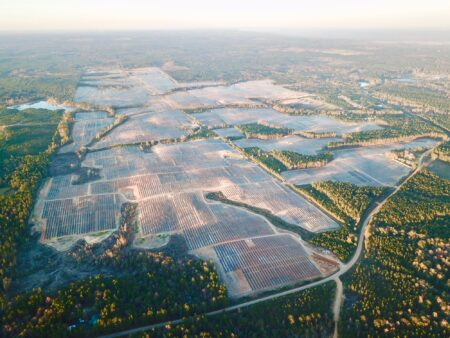Fields of Plenty: The Promise of Solar Energy
A Site Selection Web Exclusive, January 2022 – Originally posted by Site Selection Magazine.
By William Hearn, Director of Site Selection and Real Estate, Origis Energy

Two large solar farms in Hattiesburg service the energy needs of Cooperative Energy and Mississippi Power — generating more than 100 MW of clean renewable energy for Mississippi residents and employers.
Photo Provided by Origis Energy
Chances are high that if you’ve been traveling around various regions of the United States in the past few years, you have noticed a solar array where one was not previously. I have had a similar “ah-ha” moment.
You may have been struck by the fact that there are vast solar developments in more rural areas — where site selection for solar installations is more favorable, land is cheaper and larger land tracts are available. You might be further surprised to see that solar farms are popping up in most regions of the country. It’s not just your region.
“There were 280 large-scale solar project acquisitions in 2021 compared to 231 transactions in 2020. In 2021, the sector also saw the most project acquisition activity in terms of gigawatts, with more than 69 GW changing hands compared to 40 GW in 2020.”
—Mercom Capital Group 2021 Solar Funding and M&A Report, January 2021
Given that solar farms place minimal material demands on municipal services, more rural areas make sense from a siting perspective. As you glance back at the solar array you just passed, you might ask yourself the same question I did in Hattiesburg, Mississippi: “Why is this solar farm here, and what is driving the huge increase in solar energy over the past few years?”
I would argue that the solar power industry is one of the largest economic impact successes in rural America over the past decades.
As Far as the Eye Can See
My “ah-ha” moment was essentially looking over my shoulder and observing a solar array 2.5 miles by one mile in size — with more than 500,000 solar panels on trackers. Yet the array is hardly visible from the road. For me what had been a glancing interest morphed into some more serious curiosity.
I already had some familiarity with the solar industry, and took the opportunity to return to Hattiesburg and meet with Chad Newell, president of the Area Development Partnership, to discuss the how and whys of solar and Hattiesburg. Here is what I learned: The two large solar farms in Hattiesburg service the energy needs of Cooperative Energy and Mississippi Power — together they are generating more than 100 MW of clean renewable energy for Mississippi residents and employers.
Total corporate funding across the globe in the solar sector IN 2021 came to $27.8 billion, a 91% increase from 2020 and the highest total in 10 years.
—Mercom Capital Group 2021 Solar Funding and M&A Report, January 2021
This is a story that is being repeated across the Southeast as utilities seek to diversify their energy generation portfolios. These developments have made solar energy the most rapidly growing form of energy generation in the U.S. While the percentage of overall generation is small, the growth and technology advancement is impressive. According to the Solar Energy Industries Association:
- Solar has become an economic engine: In the last decade solar has achieved annual growth rates in excess of 40%. Continued massive growth is expected over future decades as technology advances and costs continue to decline, making solar the most affordable form of energy generation available.
- In 2020, over 40% of all new generation added to the grid came from solar for the second year in a row. In fact, solar has ranked first or second in this category over the past eight years. Overall, solar is responsible for 4% of total US energy generation in 2020 (Wood Mackenzie/SEIA).
- The solar workforce is now approaching 250,000 and more than 10,000 firms across the U.S., driving more than $25 billion in investment in the economy (IREC/Solar Foundation/SEIA).
- Prices continue to drop in the solar market — this includes cost advantages in the manufacturing process. Install costs have dropped 70% over the past decade. Today competitive pricing for utility-scale solar ranges from $20/MWh to $35/MWh.
Solar is likely to continue this path for some time. Among the key drivers that will support the industry going forward is the need for utilities to replace generation. The closure of coal plants continues, and that generation is being replaced by solar and natural gas at a rapid pace. Coal accounts for about 19% of energy generation, yet over 50% of carbon emissions from the sector. In the race to decarbonize, 80 coal plants with a total capacity of 98.3 GW are publicly scheduled for full retirement over the next three decades, according to the global coal plant tracker from Global Energy Monitor.
Click here to read the full article on Site Selection Magazine’s website.







